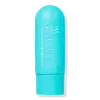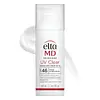What's inside
What's inside
 Key Ingredients
Key Ingredients

 Benefits
Benefits

 Concerns
Concerns

 Ingredients Side-by-side
Ingredients Side-by-side

Titanium Dioxide 6%
Cosmetic ColorantZinc Oxide 5%
Cosmetic ColorantWater
Skin ConditioningC12-15 Alkyl Benzoate
AntimicrobialDimethicone
EmollientIsododecane
EmollientTriethylhexanoin
MaskingButyloctyl Salicylate
Skin ConditioningCaprylic/Capric Triglyceride
MaskingSilica
AbrasiveCaprylyl Methicone
Skin ConditioningPolyglyceryl-3 Polyricinoleate
EmulsifyingStyrene/Acrylates Copolymer
Pentylene Glycol
Skin ConditioningMagnesium Sulfate
Triolein
Skin ConditioningPentapeptide-34 Trifluoroacetate
EmollientPentapeptide-21
Skin ConditioningLactobacillus
Skin ConditioningLactobacillus Ferment
Skin ConditioningLactococcus Ferment Lysate
Skin ConditioningBeta Vulgaris Root Extract
Skin ConditioningCurcuma Longa Root Extract
MaskingPrunus Persica Fruit Extract
AbrasivePrunus Persica Leaf Extract
EmollientResveratrol
AntioxidantMorus Alba Root Extract
BleachingEpilobium Angustifolium Flower/Leaf/Stem Extract
Skin ConditioningJasminum Officinale Flower/Leaf Extract
MaskingJasminum Officinale Flower Extract
MaskingHedychium Coronarium Root Extract
MaskingInulin
Skin ConditioningLactic Acid
BufferingPolymnia Sonchifolia Root Juice
Skin ConditioningAlpha-Glucan Oligosaccharide
CleansingLithothamnion Calcareum Powder
AbrasiveZinc Sulfate
AntimicrobialAminopropyl Triethoxysilane
Butylene Glycol
HumectantScutellaria Lateriflora Extract
Skin ConditioningCocos Nucifera Fruit Extract
EmollientTocopherol
AntioxidantDiatomaceous Earth
AbrasiveHydrangea Arborescens Root Extract
Skin ConditioningDimethicone/PEG-10/15 Crosspolymer
Dipropylene Glycol
HumectantGlycerin
HumectantDisteardimonium Hectorite
StabilisingIsostearic Acid
CleansingMaltodextrin
AbsorbentMannitol
HumectantMica
Cosmetic ColorantNylon-12
PEG-9 Polydimethylsiloxyethyl Dimethicone
EmulsifyingPolyhydroxystearic Acid
EmulsifyingPropanediol
SolventPropylene Carbonate
SolventRubus Idaeus Fruit Extract
AstringentPyrus Malus Fruit Extract
Skin ConditioningSodium Benzoate
MaskingPrunus Armeniaca Fruit Extract
Skin ConditioningSodium Citrate
BufferingSodium Metabisulfite
AntioxidantStearic Acid
CleansingEthylhexylglycerin
Skin ConditioningPhenoxyethanol
PreservativeSodium Chloride
MaskingAmmonium Hydroxide
BufferingTrisodium Ethylenediamine Disuccinate
1,2-Hexanediol
Skin ConditioningPotassium Sorbate
PreservativeCaprylyl Glycol
EmollientCitric Acid
BufferingHexylene Glycol
EmulsifyingPolysorbate 20
EmulsifyingBenzyl Benzoate
AntimicrobialLinalool
PerfumingCI 77891
Cosmetic ColorantTitanium Dioxide 6%, Zinc Oxide 5%, Water, C12-15 Alkyl Benzoate, Dimethicone, Isododecane, Triethylhexanoin, Butyloctyl Salicylate, Caprylic/Capric Triglyceride, Silica, Caprylyl Methicone, Polyglyceryl-3 Polyricinoleate, Styrene/Acrylates Copolymer, Pentylene Glycol, Magnesium Sulfate, Triolein, Pentapeptide-34 Trifluoroacetate, Pentapeptide-21, Lactobacillus, Lactobacillus Ferment, Lactococcus Ferment Lysate, Beta Vulgaris Root Extract, Curcuma Longa Root Extract, Prunus Persica Fruit Extract, Prunus Persica Leaf Extract, Resveratrol, Morus Alba Root Extract, Epilobium Angustifolium Flower/Leaf/Stem Extract, Jasminum Officinale Flower/Leaf Extract, Jasminum Officinale Flower Extract, Hedychium Coronarium Root Extract, Inulin, Lactic Acid, Polymnia Sonchifolia Root Juice, Alpha-Glucan Oligosaccharide, Lithothamnion Calcareum Powder, Zinc Sulfate, Aminopropyl Triethoxysilane, Butylene Glycol, Scutellaria Lateriflora Extract, Cocos Nucifera Fruit Extract, Tocopherol, Diatomaceous Earth, Hydrangea Arborescens Root Extract, Dimethicone/PEG-10/15 Crosspolymer, Dipropylene Glycol, Glycerin, Disteardimonium Hectorite, Isostearic Acid, Maltodextrin, Mannitol, Mica, Nylon-12, PEG-9 Polydimethylsiloxyethyl Dimethicone, Polyhydroxystearic Acid, Propanediol, Propylene Carbonate, Rubus Idaeus Fruit Extract, Pyrus Malus Fruit Extract, Sodium Benzoate, Prunus Armeniaca Fruit Extract, Sodium Citrate, Sodium Metabisulfite, Stearic Acid, Ethylhexylglycerin, Phenoxyethanol, Sodium Chloride, Ammonium Hydroxide, Trisodium Ethylenediamine Disuccinate, 1,2-Hexanediol, Potassium Sorbate, Caprylyl Glycol, Citric Acid, Hexylene Glycol, Polysorbate 20, Benzyl Benzoate, Linalool, CI 77891
Zinc Oxide 9%
Cosmetic ColorantEthylhexyl Methoxycinnamate 7.5%
UV AbsorberWater
Skin ConditioningCyclopentasiloxane
EmollientNiacinamide
SmoothingOctyldodecyl Neopentanoate
EmollientHydroxyethyl Acrylate/Sodium Acryloyldimethyl Taurate Copolymer
Emulsion StabilisingButylene Glycol
HumectantPhenoxyethanol
PreservativePolyisobutene
Triethoxycaprylylsilane
Tocopheryl Acetate
AntioxidantPEG-7 Trimethylolpropane Coconut Ether
EmulsifyingOleth-3 Phosphate
Iodopropynyl Butylcarbamate
PreservativeLactic Acid
BufferingSodium Hyaluronate
HumectantPhosphoric Acid
BufferingZinc Oxide 9%, Ethylhexyl Methoxycinnamate 7.5%, Water, Cyclopentasiloxane, Niacinamide, Octyldodecyl Neopentanoate, Hydroxyethyl Acrylate/Sodium Acryloyldimethyl Taurate Copolymer, Butylene Glycol, Phenoxyethanol, Polyisobutene, Triethoxycaprylylsilane, Tocopheryl Acetate, PEG-7 Trimethylolpropane Coconut Ether, Oleth-3 Phosphate, Iodopropynyl Butylcarbamate, Lactic Acid, Sodium Hyaluronate, Phosphoric Acid
 Reviews
Reviews

Ingredients Explained
These ingredients are found in both products.
Ingredients higher up in an ingredient list are typically present in a larger amount.
Butylene Glycol (or BG) is used within cosmetic products for a few different reasons:
Overall, Butylene Glycol is a safe and well-rounded ingredient that works well with other ingredients.
Though this ingredient works well with most skin types, some people with sensitive skin may experience a reaction such as allergic rashes, closed comedones, or itchiness.
Learn more about Butylene GlycolLactic Acid is another well-loved alpha hydroxy acid (AHA). It is gentler than glycolic acid but still highly effective.
Its main role is to exfoliate the surface of the skin by loosening the “glue” that holds dead skin cells together. Shedding those old cells leads to smoother, softer, and more even-toned skin.
Because lactic acid molecules are larger than glycolic acid, they don’t penetrate as deeply. This means they’re less likely to sting or irritate, making it a great choice for beginners or those with sensitive skin.
Like glycolic acid, it can:
Lactic acid also acts as a humectant (like hyaluronic acid). It can draw water into the skin to improve hydration and also plays a role in the skin's natural moisturizing factor (NMF) in the form of sodium lactate.
Studies show it can boost ceramide production to strengthen the skin barrier and even help balance the skin’s microbiome.
To get results, choose products with a pH between 3-4.
Lower strengths (5-12%) focus on surface exfoliation; higher strengths (12% and up) can reach deeper in the dermis (deeper, supportive layer) to improve skin texture and firmness over time.
Though it was originally derived from milk, most modern lactic acid used in skincare is vegan. It is made through non-dairy fermentation to create a bio-identical and stable form suitable for all formulations.
When lactic acid shows up near the end of an ingredient list, it usually means the brand added just a tiny amount to adjust the product’s pH.
Legend has it that Cleopatra used to bathe in sour milk to help reduce wrinkles.
Lactic acid is truly a gentle multitasker: it exfoliates, hydrates, strengthens, and brightens. It's a great ingredient for giving your skin a smooth, glowing, and healthy look without the harshness of stronger acids.
Read more about some other popular AHA's here:
Learn more about Lactic AcidPhenoxyethanol is a preservative that has germicide, antimicrobial, and aromatic properties. Studies show that phenoxyethanol can prevent microbial growth. By itself, it has a scent that is similar to that of a rose.
It's often used in formulations along with Caprylyl Glycol to preserve the shelf life of products.
Water. It's the most common cosmetic ingredient of all. You'll usually see it at the top of ingredient lists, meaning that it makes up the largest part of the product.
So why is it so popular? Water most often acts as a solvent - this means that it helps dissolve other ingredients into the formulation.
You'll also recognize water as that liquid we all need to stay alive. If you see this, drink a glass of water. Stay hydrated!
Learn more about WaterZinc Oxide is a mineral broad-spectrum UV filter; it is the broadest UVA and UVB reflector approved by the FDA. It also has skin protectant and skin soothing properties.
Zinc oxide is one of the most effective broad-spectrum UV filters. It protects against UVB, UVAII, and UVAI. In comparison to its counterpart titanium dioxide, zinc oxide provides uniform and extended UVA protection.
Another great benefit? This ingredient is highly photostable so it won't degrade easily under sunlight.
A common myth is that mineral UV filters are widely believed to primarily reflect UV light.
However, modern research shows titanium dioxide absorbs UV radiation like chemical filters (~95% absorption & 5% reflection).
Zinc oxide has great skin soothing properties so you'll likely find this in sunscreens formulated for sensitive skin or babies/children. It is unlikely to cause "eye sting" like other sunscreen ingredients.
Regulatory agencies consider zinc oxide to be non-toxic and safe. It has also been shown to not penetrate the skin.
Unfortunately, this ingredient does leave a visible white cast. This is why mineral sunscreens are often less cosmetically elegant than chemical or hybrid ones.
In cosmetics, zinc oxide can be found in both non-nano and nano-sized forms. The nano version is used to reduce white cast and improve the texture of sunscreen formulas.
There are ongoing concerns surrounding nano-zinc oxide's impact on marine ecosystems and whether it can be absorbed into skin.
Regarding marine ecosystems and coral reefs, there is no conclusive evidence that any form of zinc oxide (or any other sunscreen ingredients) will cause harm. The science is still developing but many consumers are keeping a close eye on this issue.
Please note, many destinations have reef-safety sunscreen rules. For instance, the U.S. Virgin Islands advises all visitors to use non-nano mineral sunscreens.
There has also been some stir about whether micronized or nano zinc oxide has potential photoxicity and absorption through the skin/lungs.
An in-vitro (done in a test tube or petri dish) study demonstrated micronized zinc oxide to have potential phototoxicity. There's no need to fret; the EU Commission's Scientific Committee on Consumer Safety has stated, "The relevance of these findings needs to be clarified by appropriate investigations in vivo." Or in other words, further studies done on living organisms are needed to prove this.
Current research shows zinc oxide nanoparticles do not penetrate intact or sunburned skin. They either remain on the surface or in the outermost layer of dead skin (stratum corneum).
Zinc oxide is one of only two classified mineral UV filters with titanium dioxide being the other one.
Fun fact: Zinc has been used throughout history as an ingredient in paint and medicine. An Indian text from 500BC is believed to list zinc oxide as a salve for open wound. The Ancient Greek physician Dioscorides has also mentioned the use of zinc as an ointment in 1AD.
Learn more about Zinc Oxide